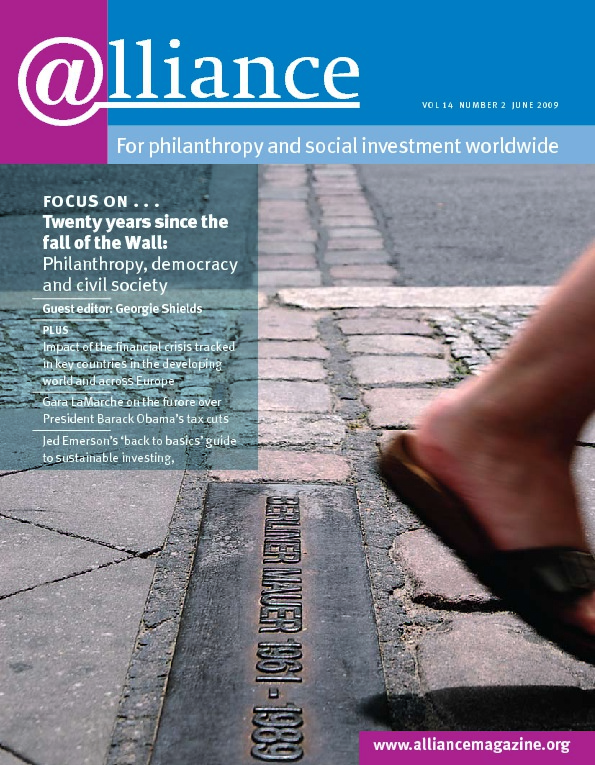At a time when social investments and philanthropy are trying to find their way amid the global recession, one financial instrument available combines the two: community bonds. Community bonds allow people to support a charitable cause while knowing that the money will be returned to them at the end of the investment period.
Community bonds are neither a charitable donation nor a social investment but a hybrid between the two. The bonds have been used to tackle challenges such as unemployment and poverty-related debt and to boost enterprise start-ups and affordable housing, as well as providing funding for microcredit.
This type of bond can appeal to regional wealth managers interested in engaging their clients with local issues. The practice can be found in the UK, the US and Canada. In the UK, the organizations Citylife and Charity Bank, as well as the mainstream bank NatWest, offer community bonds. In the US, the Calvert Foundation offers its own version of a community bond, but it is employed globally.
In the UK, Citylife, founded in 1999, pioneered the use of community bonds by creating a five-year zero-coupon social investment bond as a means of fundraising by communities and charities. Citylife bonds are Financial Services Authority (FSA)-compliant charitable financial instruments that are held under trust. Through its bonds, Citylife has raised more than £10 million for charities, which it estimates has led to £35 million being invested in communities around the UK.
Tim Jones, chief executive of Citylife, said community bonds have proved to be so successful because they allow people to be philanthropic knowing that their money will eventually be returned to them. ‘People want to help causes they care about. The philanthropic urge is a human condition,’ he said. ‘But you also want to help yourself, and there’s a nervousness about giving large sums of capital away.’
Mr Jones said that the bonds appeal both to corporations, which can make large donations and fulfil their corporate and social responsibility goals, and individuals who want to help their communities. ‘They’re very good at building relationship bridges in the community,’ he said. ‘They each have one bond, and they each have one vote. It’s very levelling and very inclusive.’
Charity Bank, the UK bank that uses its deposits to fund charities and social enterprises and is the only FSA-regulated charity and bank, created a Yorkshire Deposit Bond in 2007 to fund charity borrowers in the region. The offering has raised more than £4 million, which has been used to benefit charities in the Yorkshire and Humber regions.
Malcom Hayday, chief executive of Charity Bank, said the bank is now considering offering community bonds in other regions of the country, with the next community bond offering to be in Wales later this year. He said the bonds were growing in popularity both because of the disenchantment of the large national banks and from a desire to do something. ‘We offer opportunities for people to visit the projects that they’re supporting. Sometimes there might be projects only 15 miles from their own front door, which has a certain amount of pull for a depositor,’ he said. ‘It’s not going to appeal to everybody, but a growing pool of people think this is a good idea.’
In the US, the Calvert Foundation offers the Calvert Community Investment Note, its flagship product and most popular offering, which funds organizations around the world. Investors can choose the term, from one to ten years, as well as the interest rate, from 0 to 3 per cent. About 10 per cent of investors choose a zero-coupon bond. The lower the interest rate, the greater the benefit to the non-profit borrowers who the bond aids.
Investments in the note are pooled and placed in a portfolio of affordable loans granted to more than 200 non-profit organizations and social enterprises working in more than 100 countries. The money has been used for affordable housing, microcredit, small business development, community facilities and social innovations.
In Canada, the Municipal Finance Authority of British Columbia has its own Community Bond Program that has raised money throughout the province since its inception in 1995. The programme is pitched to communities that need financing for capital projects but have been unable to raise the money through traditional municipal bonds.
As the third sector struggles to find more sustainable funding, community bonds might be an idea whose time has come.
Investors’ perspectives is produced in collaboration with Investing for Good, a social finance intermediary and asset manager founded in 2004.
http://www.investingforgood.co.uk
Maureen Stapleton is an analyst at Investing for Good in London. Email mstapleton@investingforgood.co.uk
Also of interest
- Measurement vs action: letters from Andrew Milner, David Devlin-Foltz and Lisa Molinaro, and Tris Lumley
- GSIX – a new global network for social investment
- Jed Emerson on why investors should go back to basics
- Social banks and faith-based charities defy crisis in UK
- Reports from an impact evaluation conference in Cairo and the Skoll World Forum


Comments (0)